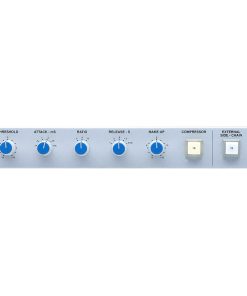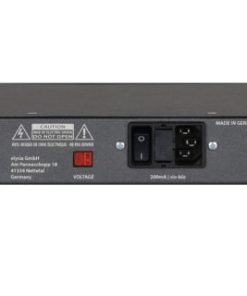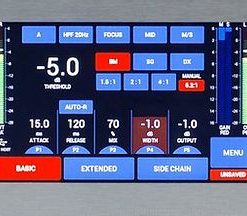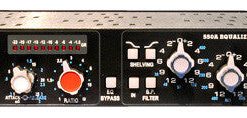Solid State Logic G Series Compressor Solid State Logic – SSL
$ 3.499,00 $ 874,75
The SSL G Series Compressor is a 1U rackmountable version of the famous center-section bus compressor built into the SL 4000 G-series console, renowned for its punch, drive, and ability to finalize a mix
Perhaps the most well-known and oft-used unit made by SSL is the Channel G Bus Compressor. Previously a secret weapon of choice used by mix engineers at all levels of popular music, the G-Series Bus Compressor had its origins in the SSL G-series console master section, and later became available as a single rackspace unit. The G-Series compressor is one of the best mix-glue dispensers of the last several decades, also known for its ability to bring out the midrange of digital recordings (typically thin in digital yet critically important to music). The G-Series Bus Compressor is also one of the most copied compressors in both hardware and software, and as they say, imitation is the highest form of flattery – but if flattering your mix is all you care about, then a G-Series Bus Compressor needs to be in your rack and on your mixes. And like all the most popular recording gear, it’s easy to use and gets great results every time.
SSL G Series Compressor – Just the Facts:
- Legendary SSL G-Series stereo bus compressor
- Gain-reduction meter as found on the classic SSL console range
- External sidechain source select
- Auto-fade with rate control automatic linear fade in/out control
- Remote connector for remote operation of the auto fade function
SSL G Series Compressor – Under the Hood
A 1U rackmount version of the SSL G-Series console master bus compressor, it combines the classic G-Series bus compressor design elements with SuperAnalogue topology. The result is a universally acclaimed compression characteristic with spectacular audio performance.
Initially released as the FX384, which still retains its status as a cult classic and the source of many a debate between old versus new, the XLogic G-Series Compressor is the latest version of the compressor. It uses the same classic twin VCA design as its console counterpart. The main difference is that the FX384 had a roll-off at 40kHz, while the new G-Series Bus Compressor rolls off at a much higher frequency, thanks to improved input and output circuitry. Also, thanks to SSL’s SuperAnalogue DC-coupled circuitry, the G-Series Bus Compressor doesn’t suffer from the inconsistencies of capacitors in the circuit path as does the older FX384 bus compressor. The important thing is that the G-Series Bus Compressor retains the dynamics characteristics that have defined hit mixes for decades, and in blind listening tests, even SSL designers and engineers could tell the difference only 50% of the time.
1U G Series Compressor – Outside the box
Compressor controls
The compressor’s front-panel controls are straightforward and as such don’t require a master’s degree in electrical engineering to explain. The attack, ratio, and release controls are multi-position switches, while the threshold and makeup-gain controls are continuously variable potentiometers.
The illuminated compression meter to the left of the unit displays gain reduction for the compressor. If required, a secondary (non-illuminated) meter can be connected via a remote connector on the rear of the unit.
Going into a little more depth, be aware that the knee point of the compressor, set by the threshold control, is interdependent on the ratio control, purposely changing depending on the ratio setting. Decreasing the ratio setting lowers the effective threshold, maintaining the perceived loudness of the compressed signal. Also noteworthy is the Auto setting on the Release control, which seems almost magical in its ability to provide just the right amount of release for just about any program material that passes through the compressor.
External Sidechain
The compressor sidechain can be driven either by the main stereo channel (the loudest signal wins), or by an external (mono) signal applied to the Key input on the rear of the unit. This feature is enabled by the External Sidechain switch on the front panel and enables the unit to be used as a ducker (for audio-follow applications) or as a de-esser with external EQ.
Autofade
The final part of the G-Series Bus compressor is the Autofade switch and its associated rotary control, which provides a timed fade out or fade up with a time of 1 to 60 seconds. Pressing the switch will fade the audio out in the time set on the rotary control. Releasing the switch will fade the audio back up in the same amount of time (the fade time can be adjusted at any time). The Autofade switch is illuminated whilst the signal is fading down, remaining so until the signal has returned to normal gain. This function can also be activated remotely via a switch and associated 24V tally lamp connected via the Remote socket on the rear of the unit.
A little SSL console history
The SL 4000 was the first console to incorporate dynamics processing in every channel and a master compressor in the console center section (which became the aforementioned FX384).
The ability to patch into the SL 4000’s center compressor, plus the ability to control its sidechain from an internal sub-mix, allowed engineers to experiment on instruments such as piano and drums, which gave rise to some unique and amazing sounds, such as shimmering piano and acoustic guitar, as well as punchy drums – not to mention its classic mix finalizing capabilities. This versatility created the demand for a rack mount version and a legendary piece of outboard gear was born.
The SL 4000 G console owes much of its success to the G-Series center section compressor, which is responsible for the punch and drive heard on chart-topping music for decades. Order yours today, or for more information, call or chat online with your PAD Studio Specialist today.
Specifications
Performance*
Noise
- Noise: < -90dBu (Input terminated with 50 ohms. Compressor switched in and makeup set for 0dB gain)
Headroom (Defined at the output level at which THD exceeds 1%)
- Headroom: > +28dBu output level, 20Hz to 20kHz at 0dB gain
- Dynamic Range: > 118dB
Frequency Response
- 20Hz to 20kHz: ±0.2dB (-3dB @ 100kHz)
Measured reference level at 1kHz. Any gain setting. Source impedance 50 ohms.
Common Mode Rejection Ratio
- CMRR: 20Hz to 10kHz: > 50dB
Input level +20dBu, ground referenced
THD + Noise (Gain +0dB, input level +4dBu. Compressor switched out)
- 20Hz to 20kHz (80kHz filter): < 0.008%, typically 0.005%
- 20Hz to 20kHz (80kHz filter): < 0.01%, typically <0.006%
THD with the compressor switched in is dependent on attack and release times and signal content.
Crosstalk**
- Crosstalk @ 50Hz: < -110dB
- Crosstalk @ 1kHz: < -100dB
Impedance
- Input impedance:> 10k ohm
- Output impedance: < 50 ohm
Power consumption
- Power: 23 watts / 29VA
Physical (approx.)
- Height : 1-3 /4″ / 44.5mm (1 RU)
- Width: 19″ / 480mm
- Depth: 13-13/16″ / 350mm; 16-3/4″ (including connectors)
- Weight: 7.5 lb. / 3.3kg
*Source impedance 50 ohms unless otherwise stated. All measurements are RMS and are made using a 22Hz to 22kHz filter unless otherwise stated.
** Apply +20dBu test tone to either channel input with the other input terminated with 50 ohms. Crosstalk is the ratio of level at the output of the test channel and the output of the channel to which the signal is applied.
Prompt Delivery and Professional Packaging
Our long-standing partnership with UPS FedEx DHL and other global carriers lets us offer a range of shipping services. Our warehouse staff is extremely skilled and will package your items according to our precise and exact specifications. Your goods will undergo an extensive inspection and be safely packaged prior to being sent out. Each day, we ship to thousands of customers in many countries. The fact that we are committed to becoming the biggest online retailer in the World is clear. These warehouses are in Europe in the same way as they are in USA.
Note: Orders that include more than one item are assigned a processing period depending on the item.
Before shipping, we will inspect thoroughly the items you have ordered. Most orders are shipped within 48 hours. Expected delivery time is between 3-7 days.
Returns
Stock is dynamic. It's not entirely managed by us since we are involved with multiple entities, including the factory and the storage. The actual stock can change at any moment. It is possible that your order may be out of stock once the order has been placed.
Our policy lasts for 30 days. We cannot exchange or refund your order if it has been 30 days from the date of purchase.
For your item to be returned it must be in its original packaging, unopened and in the condition you received it. The item must be in its original packaging.
Related products
Compressor
Channel Strip
500 Series Compressor
Compressor
Compressor
Compressor
Recording Equipments
Mastering Compressor
Plugin
500 Series Compressor
Recording Equipments
Compressor
Channel Strip
Compressor
Mastering Compressor
Compressor
Compressor
Recording Equipments
Compressor





























































